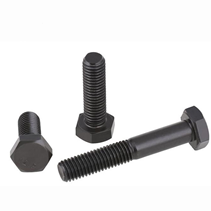Basic knowledge of carbon steel standard parts
I. Definition of carbon steel
Carbon steel, referred to as carbon steel, refers to the carbon content of more than 0.0218% and less than 2.11%, and not specially added alloying elements during smelting, is the most basic iron-carbon alloy.
Carbon steel is an iron-carbon alloy containing small amounts of silicon, manganese, sulfur, phosphorus and other impurity elements.Carbon steel inevitably contains some impurity elements during smelting, which has great influence on the properties and quality of steel.
The influence of impurity elements on the properties of carbon steel
1) The influence of silicon
Sources: Pig iron and deoxidizer
Influence: Residual silicon can dissolve in ferrite, make ferrite strengthen, improve the strength and hardness of steel.
(2) make the liquid flow of steel better, conducive to casting molding.
Content: Silicon as a constant element, its content generally does not exceed 0.5%.
2) The effect of manganese
Sources: Pig iron and deoxidizer.
Influence: (1) it can be synthesized with manganese sulfide in steel, so as to reduce the harmful effect of sulfur.
Most of the residual manganese can dissolve in ferrite to improve the strength and hardness of steel.
Content: generally less than 1%.
3) The effect of sulfur
Source: Pig iron and fuel.
Influence: It is very harmful to steel.
(1) It does not dissolve in iron, but exists in the form of FeS,FeS and Fe form a low solution point (985℃) eutectic, in steel forging, rolling and other hot processing, weaken the binding force between the steel internal molecules, leading to cracking.It’s called “hot crisp.”
(2) sulfur will also reduce the strength and toughness of steel.
(3) sulfur and manganese combined into manganese sulfide, chip breaking role, can improve the cutting.
Content: should be strictly controlled, generally less than 0.050%
4) The influence of phosphorus
Source: Pig iron.
Influence: (1) can be completely soluble in ferrite, improve the strength and hardness of steel;
The plasticity and toughness of steel decreases sharply when the temperature is lower than 100℃. This phenomenon is called “cold and brittle”.The higher the phosphorus content, the more serious the cold and brittle;
(3) The ferrite embrittlement in the range of 0.05% to 0.15% can improve the machinability.
(4) Phosphorus will also make the welding performance of steel bad, when welding easy to crack.
Content: Generally less than 0.045%.
For example, in shell steel, the phosphorus content is high, the purpose is to improve the brittleness of steel, increase the fragmentation degree of shrapnel, improve the lethality of the shell.
5) Other gases and non-metallic inclusions
Hydrogen embrittlement: Hydrogen molecule – high pressure – white point – hydrogen embrittlement
Aging of nitrogen: nitrogen that has no time to escape, after being placed for a period of time, is precipitated in the form of nitrides to make steel brittle.
Oxygen exists in steel in the form of oxides, forming non-metallic inclusions, such as SiO2, MnO, Al2O3, etc., which reduce the plasticity, impact toughness and fatigue strength of steel.
